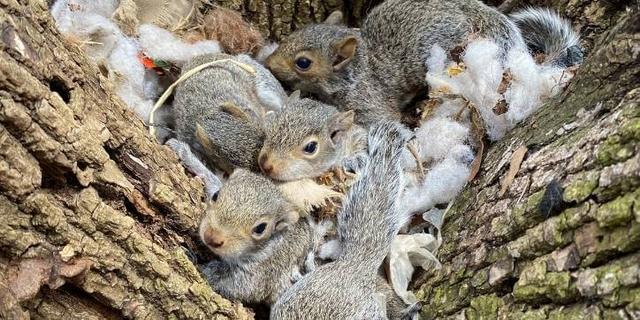Squirrels are fascinating creatures that many of us encounter in our backyards and local parks. As an avid outdoorsman and wildlife observer, I’ve always been intrigued by their behavior, especially during breeding season. Let’s explore the reproductive habits of these bushy-tailed rodents and answer the question – how many babies do squirrels typically have?
Squirrel Breeding Seasons
Squirrels generally have two breeding seasons per year:
- Winter breeding season: December to February
- Summer breeding season: June to August
This biannual breeding cycle allows squirrels to produce two litters each year in most cases. The timing may vary slightly depending on the species and local climate conditions.
Gestation Period
After mating, female squirrels have a gestation period of about 38 to 46 days. This relatively short pregnancy allows them to give birth twice a year:
- Spring litter: Born between February and April
- Fall litter: Born in August or September
Litter Size
So how many babies are in a typical squirrel litter? On average, female squirrels give birth to 2-4 babies per litter. However, litter sizes can range from 1-8 depending on factors like:
- Species of squirrel
- Age and health of the mother
- Food availability
- Environmental conditions
In my observations, I’ve most commonly seen litters of 3-4 baby squirrels. Larger litters of 5 or more seem to be less frequent, at least in the Eastern gray squirrels common in my area.
Caring for Baby Squirrels
Female squirrels are devoted mothers. They will care for their babies, called “kits” or “kittens,” in the nest for about 10 weeks. During this time, the mother will:
- Keep the babies warm
- Nurse them frequently
- Protect them from predators
- Begin teaching them survival skills
At around 10-12 weeks, the young squirrels will be weaned and start venturing out of the nest. They’ll stay with their mother for a few more weeks, learning essential skills like:
- Foraging for food
- Climbing trees
- Evading predators
- Building nests
Where Do Squirrels Have Their Babies?
Squirrels give birth and raise their young in nests, which can be one of two types:
- Tree cavity dens – These are holes in trees, often abandoned woodpecker nests. They provide excellent protection from the elements and predators.
- Leaf nests (dreys) – These are constructed high up in trees using leaves, twigs, and grass. While less secure than cavities, they’re more readily available.
Female squirrels often maintain multiple nests, moving their babies if one becomes compromised. This strategy helps protect the vulnerable young from predators and harsh weather.
What To Do If You Find Baby Squirrels
As someone who spends a lot of time outdoors, I’ve occasionally encountered baby squirrels that appear to be alone or in distress. Here’s what I’ve learned about handling these situations:
- Observe from a distance. The mother may be nearby foraging for food.
- If the baby is uninjured and has fur, leave it be. The mother will likely return.
- For hairless or injured babies, contact a wildlife rehabilitator for advice.
- Never try to raise a baby squirrel yourself. They require specialized care and diet.
- If you must move a baby squirrel, place it in a shallow box near where you found it, out of direct sunlight. The mother may come to retrieve it.
Remember, it’s always best to let nature take its course when possible. Human intervention should be a last resort.
Conclusion
Squirrels typically have 2-4 babies per litter, with two litters per year. These prolific breeders play an important role in our ecosystems, helping to disperse seeds and serving as prey for larger animals.
Next time you’re out enjoying nature, take a moment to observe these clever creatures. You might just catch a glimpse of a mother squirrel teaching her young ones the ropes of squirrel life!
Have you ever encountered baby squirrels in your backyard or on a hike? Share your experiences in the comments below. And if you found this article helpful, don’t forget to check out more wildlife content on Air Gun Maniac!








